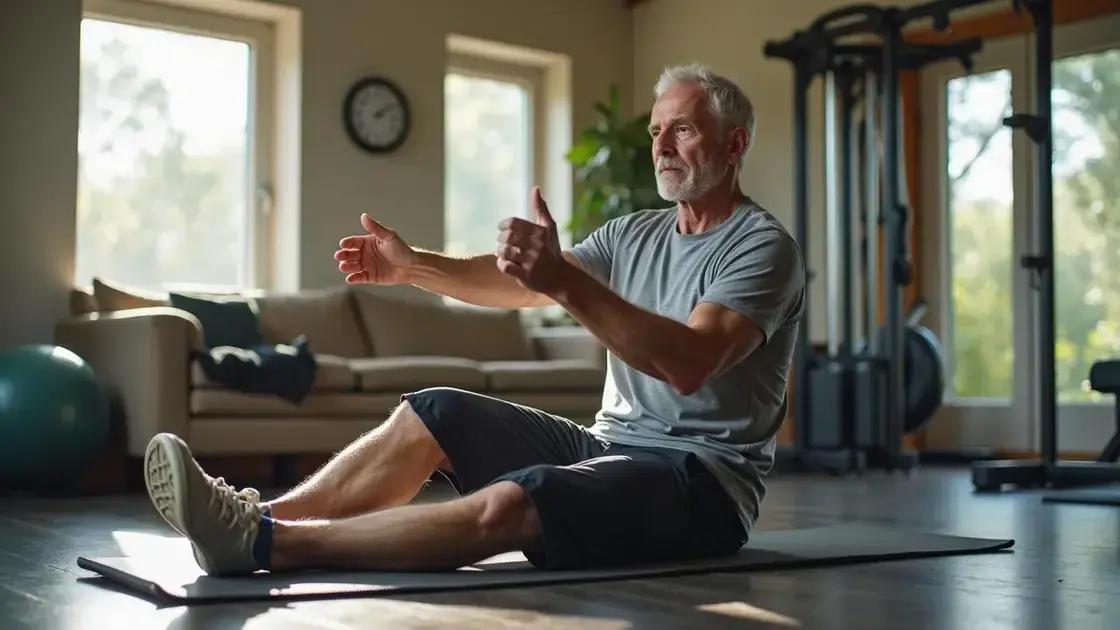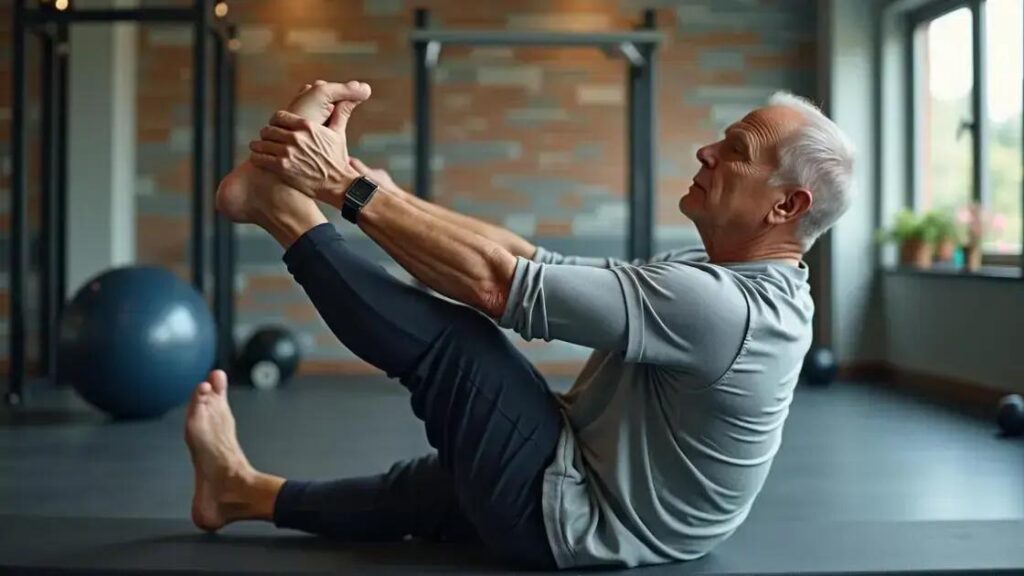The benefits of rotational core training for men over 50 include improved core strength, enhanced balance and stability, increased functional fitness, and reduced injury risk, making it an essential component of a fitness routine tailored to older adults.
As men age, staying fit and healthy becomes increasingly important. The benefits of rotational core training for men over 50 can be transformative. This specialized form of exercise focuses on improving core stability and strength, which are crucial for maintaining overall fitness and functionality. In this article, we will delve into what rotational core training entails, explore its numerous benefits, discuss how to effectively integrate it into your routine, and provide essential safety tips to ensure a successful and injury-free workout experience.
Understanding Rotational Core Training

Rotational core training is an exercise approach that focuses on strengthening the muscles of the core, particularly those responsible for rotational movements. This type of training is essential for everyone, especially for men over 50, as it enhances functional fitness and plays a vital role in daily activities.
What is Rotational Core Training?
Rotational core training involves exercises that engage the muscles in your abdomen, back, and hips, promoting strength and flexibility. Unlike traditional core workouts that often focus on static movements, rotational training emphasizes dynamic movements that mimic real-life activities.
Key Components of Rotational Core Training
This training form targets various muscle groups through movements that rotate the torso. Exercises such as cable woodchoppers, medicine ball twists, and Russian twists are popular choices. These exercises help improve not only core strength but also overall body stability, which is crucial for maintaining mobility and preventing injuries.
Importance for Men Over 50
As men age, muscle mass and bone density can decrease. Engaging in rotational core training helps combat these natural declines by building strength in the core, which supports the spine and prevents falls. It also enhances balance, stability, and coordination, making it easier to perform everyday tasks.
Understanding rotational core training is a gateway to harnessing its benefits. By incorporating these exercises into a fitness routine, men over 50 can not only improve their physical health but also boost their confidence in staying active and independent.
Key Benefits for Men Over 50

There are numerous key benefits of rotational core training specifically for men over 50. With age, it becomes even more important to engage in exercises that not only build strength but also enhance overall well-being.
Improved Core Strength
Rotational core training effectively targets the muscles in the abdomen and lower back. Strengthening these muscles leads to better posture and helps in performing daily activities with ease.
Enhanced Balance and Stability
As men age, maintaining balance becomes crucial to prevent falls and injuries. This training focuses on movements that improve stability, enhancing coordination and balance.
Increased Functional Fitness
This type of training mimics real-life movements. By improving functional fitness, men are better equipped to handle everyday tasks like lifting and twisting without strain.
Reduced Injury Risk
Engaging in rotational core exercises strengthens the muscles that support the spine. A stronger core can help prevent injuries, especially as the body becomes more susceptible to strains and sprains with age.
By understanding the key benefits of rotational core training, men over 50 can make informed decisions about their fitness routines, ultimately leading to a healthier and more active lifestyle.
How to Incorporate Rotational Core Exercises

Incorporating rotational core exercises into your fitness routine is easy and can be done anywhere. Here are steps to effectively add these exercises to your regimen:
Start with a Warm-Up
Before engaging in any exercise, it’s important to warm up. Spend 5-10 minutes doing light cardiovascular activities such as walking or cycling. This gets your blood flowing and prepares your muscles for work.
Select Core Rotational Exercises
Choose exercises that focus on different aspects of core rotation. Some effective options include:
- Cable Woodchoppers: Use a cable machine and rotate your torso while pulling the cable down.
- Medicine Ball Twists: Sit on the floor with knees bent and rotate your body side to side while holding a medicine ball.
- Russian Twists: Sitting with feet lifted, twist your torso to touch the ground beside you, alternating sides.
Build a Routine
Incorporate these exercises into your regular workouts by performing them 2-3 times per week. Aim for 2-3 sets of 10-15 repetitions for each exercise, gradually increasing as you build strength.
Focus on Form
Proper form is crucial to prevent injury. Keep your back straight and engage your core throughout each movement. If needed, work with a trainer to ensure your technique is correct.
By following these steps, you can easily incorporate rotational core exercises into your fitness routine. This will help you reap the many benefits of stronger core muscles and improved stability.
Safety Tips for Rotational Core Training

Practicing safety is crucial when engaging in rotational core training, especially for men over 50. Here are some important tips to ensure a safe workout.
Consult Your Doctor
Before starting any new exercise program, it’s a good idea to consult your healthcare provider. This is especially important if you have any existing health conditions or concerns.
Warm Up Properly
Always begin your workout with a thorough warm-up. Spend at least 5-10 minutes performing dynamic stretches to prepare your muscles and joints for the movements ahead.
Listen to Your Body
Pay attention to how your body feels during exercises. If you experience any pain or discomfort, stop the exercise immediately. It’s important to differentiate between discomfort from exertion and pain that could indicate injury.
Use Proper Technique
Focus on using the correct form to prevent injuries. If you’re unsure how to perform any exercise, consider working with a qualified trainer who can guide you on proper techniques.
Start Slow and Progress Gradually
Begin with easier exercises and gradually increase the intensity as you become more comfortable. This progressive approach reduces the risk of injury and builds strength over time.
Stay Hydrated
Drink plenty of water before, during, and after your workout. Staying hydrated helps maintain performance and supports recovery.
By following these safety tips for rotational core training, men over 50 can enjoy their workouts while minimizing the risk of injury.
In Conclusion: Embracing Rotational Core Training
The benefits of rotational core training for men over 50 extend beyond just physical strength; they enhance overall quality of life. By understanding its principles and benefits, incorporating effective exercises, and following safety measures, older men can improve their core strength, stability, and functional fitness.
Engaging in these tailored workouts not only helps in maintaining independence but also reduces the risk of injury, ensuring a more active lifestyle. As you embark on this journey, remember to listen to your body, start gradually, and consider seeking guidance from fitness professionals.
With dedication and consistency, rotational core training can be a valuable addition to any fitness routine, helping men over 50 to stay strong, fit, and resilient.
FAQ – Frequently Asked Questions about Rotational Core Training for Men Over 50
What is rotational core training?
Rotational core training focuses on strengthening the core muscles through exercises that emphasize twisting and rotation, improving overall stability and strength.
Who can benefit from rotational core training?
Men over 50 can greatly benefit from rotational core training as it helps improve functional fitness, balance, and reduces the risk of injury.
How often should I perform rotational core exercises?
Aim to incorporate rotational core exercises into your routine 2-3 times per week, with 2-3 sets of 10-15 repetitions for each exercise.
What safety precautions should I take?
Consult your doctor before starting, warm up properly, ensure correct form, and listen to your body to avoid injuries.
Can I do rotational core exercises at home?
Yes, many rotational core exercises can be done at home using minimal equipment, like medicine balls and resistance bands.
What are some examples of rotational core exercises?
Examples include cable woodchoppers, medicine ball twists, and Russian twists, all focusing on engaging the core through rotational movements.













